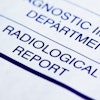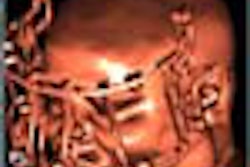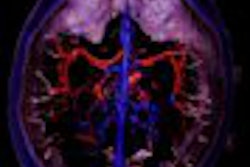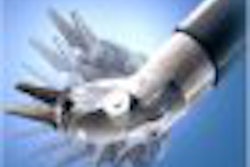While permanent brachytherapy seed implantation has gained ground for the treatment of prostate cancer, a uniform standard of care is still in the works. Helping create the standard are radiation oncologists, who are using their experience to fine-tune their techniques and help make brachytherapy programs more successful.
In a presentation at the 2001 American Society for Therapeutic Radiology and Oncology (ASTRO) meeting in San Francisco, Dr. Bradley Prestidge shared some of the elements of his group’s prostate brachytherapy plan.
"I think prostate brachytherapy techniques are kind of like fingerprints. It seems that there are no two that are identically the same," said Prestidge, who is with the department of radiation oncology at the Cancer Therapy Research Center in San Antonio. "There are a lot of variables: Whether you use a preplanning technique versus intraoperative technique; whether you use preloaded needles or Mick applicator needles; the amount of ultrasound that is used versus the amount of fluoroscopy; the type of stabilizing system."
But certain criteria must be met for successful results. Prestidge, who said he has been performing prostate brachytherapy for a dozen years, outlined the general rules of thumb that anyone doing prostate brachytherapy should consider, as well as some ideas on how his team approaches the procedure.
Anesthesia
"In our practice, we use general anesthesia for three reasons," Prestidge said. "First, the induction part of the anesthetic is quick. The second reason is that the recovery period is very rapid; patients come out of it really quickly. Also, we have no patient motion."
Another option is spinal anesthesia, but Prestidge said his group reserves that method for patients with a high cardiopulmonary risk.
Position and preparation
If a preplanned approach is used, the patient should be in the same position he was in for the ultrasound volume study, particularly with regard to the degree of hip flexion. In addition, "the patient should be straight on the table. This is something that I see people overlook quite a bit," Prestidge warned. "Make sure that the patient is aligned straight on the table so that the ultrasound probe is parallel to the midline of the patient’s body."
Catheters are used because they help visualize the urethra and place traction on the prostate gland, helping to immobilize it, he added.
Anchoring the prostate
Anchoring needles are placed toward the peripheral part of the prostate gland and are pushed toward the base in order to increase traction. Multiple needles are used and arranged from anterior to posterior positions. A Foley balloon is put in place as a stabilization aid and to help with landmarks on imaging.
"There are number of ways to do that. The first one that might come to mind is to use some form of a stabilization needle. We use Morgenstern needles. We find that these are helpful, although they are certainly not a panacea. We can fall into a trap sometimes where we assume that once you put an anchoring needle in, nothing is going to move and you can just forget about it," Prestidge said. "We always make sure to re-base. Once you’ve put your stabilizing needles in, study the longitudinal ultrasound image and realign the zero plane. We take a few moments to find that, look at where the base is, look at where the apex is, and look at where the urethra is."
The Foley catheter position is also inspected to ensure that it gently retracts the prostate.
Needle placement
"My criteria for a good preloaded needle is one that you can manipulate well; that you can tell from the hub which direction it’s going. That kind of information is based on where the bevel [of the needle] is pointed," Prestidge said.
One concern with using multiple preloaded needles is that the stylets may bump during the procedure, accidentally deploying the brachytherapy seeds. Prestidge and his team have dealt with this issue by having one person hold the previously placed needles in place, while a second person inserts the new ones, generally working from bottom to top or from the inside to the outside.
The needle placement is then checked on an axial ultrasound image. Assessing the location of the three needles in the midline of the body, near the rectum, is especially crucial, Prestidge said.
"You have to be mindful of the depth of these needles. After looking on the axial image, switch to the longitudinal [image] and be mindful of where that apex is with regard to the rectal mucosa. It varies a great deal according to the degree of hip flexion and the patient’s anatomy," he explained.
"Once the tip of the needle is set to the depth that we want, then the needle and stylet is advanced just slightly. If you turn the needle correctly, you can actually see the seed coming between the walls of the needle. The seed is deployed in the position you want, the stylet is held still, and the needle retracts," Prestidge said. "Implant the gland, not the grid. Keep in mind that when you are told to position the needle in one particular coordinate, if you look and it doesn’t make sense, look at your ultrasound image."
Fluoroscopy
Fluoroscopy is used by Prestidge’s team only at the end of the procedure, as a way to confirm the final placement of the seeds.
"In our practice, fluoroscopy has really taken a back seat to the ultrasound imaging. We feel like we can see so well where the needles are on longitudinal ultrasound imaging, it’s very rare that we perform a fluoroscopic exam and find that the seeds are not where we wanted them," he said.
However, the fluoroscopic exam is still done for the purposes of documentation and for seed confirmation. On some occasions, extra seeds, called voodoo seeds, are added based on fluoroscopic results, but "you have to be careful," Prestidge warned. "Sometime we do nice seed implants and then mess ourselves up by adding extra seeds, really pushing up the dose in the parts of the gland where we don’t want it." Voodoo seeds should not be placed too near the gallbladder or too near the midline, he said.
Regardless of the chosen technique, Prestidge recommended that any prostate brachytherapy program contain the following:
- Good equipment, especially an ultrasound system. Even if everyone is satisfied with the current system, Prestidge encouraged attendees to keep up with the latest equipment developments.
- Teamwork. "Using the same personnel to some extent is very helpful because the more you work together as a team, that will really improve your implant [procedure] quality," he said.
- Quality assurance. Before surgery, personnel should discuss patient selection, the type of seed that will be used and why, and patient history. After the procedure, talks on dosimetry and morbidity can help improve technique.
- Resources. Seek outside help from vendors or consultants who may have already addressed, and solved, the problems that can sometimes plague a new prostate brachytherapy program.
And while the intricacies of the procedure may fascinate radiation oncologists, they must keep in mind that other members of the surgical team may not be so enamored of the theory behind prostate brachytherapy. Speed should go hand-in-hand with expertise.
"For the most part, this procedure involves urologists, and they are accustomed to proceeding quickly and efficiently," Prestidge said. "A lot of times, programs die on the vine because it was taking two to three hours to do the first few implants. The urologists get a bad impression and didn’t think it was worth doing. Definitely look at ways you can pick up speed and efficiency."
By Shalmali PalAuntMinnie.com staff writer
November 21, 2001
Related Reading
Is fixed dosimetry in brachytherapy a prescription for trouble? November 8, 2001
Most men maintain erectile function after brachytherapy, November 5, 2001
PSA rise and positive biopsy after brachytherapy may not signal cancer, August 29, 2001
Brachytherapy for prostate cancer improved by computer model, February 21, 2001
Copyright © 2001 AuntMinnie.com



















